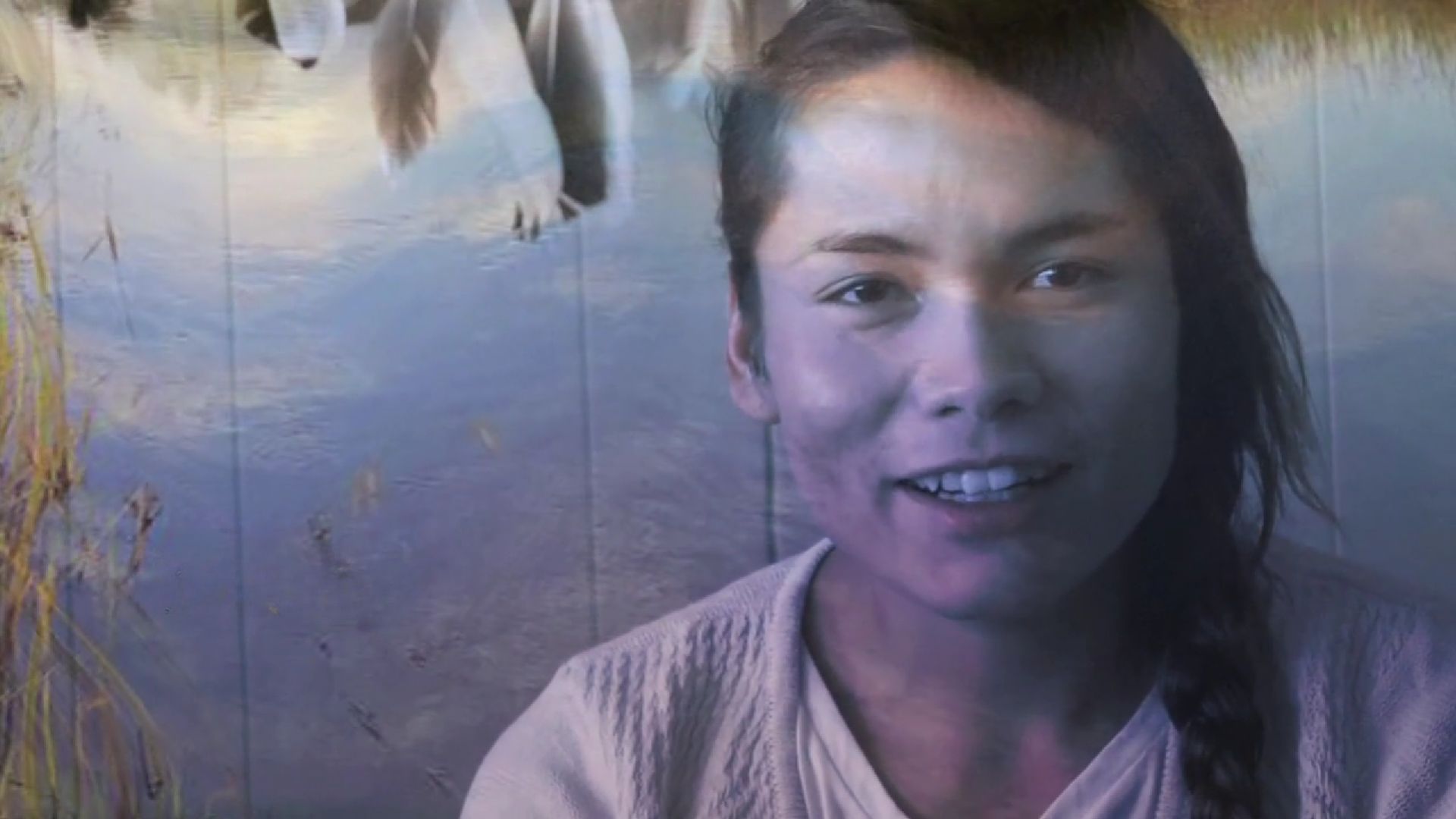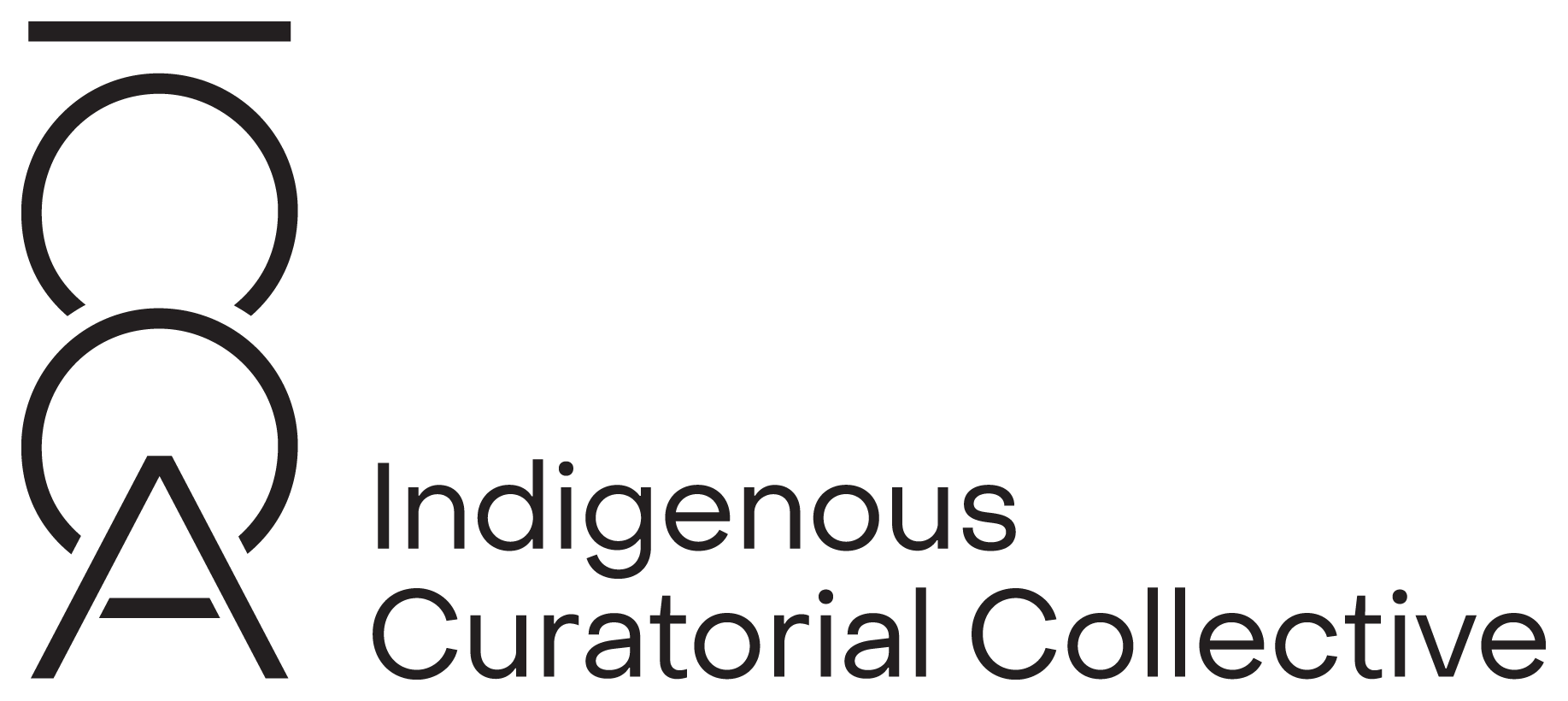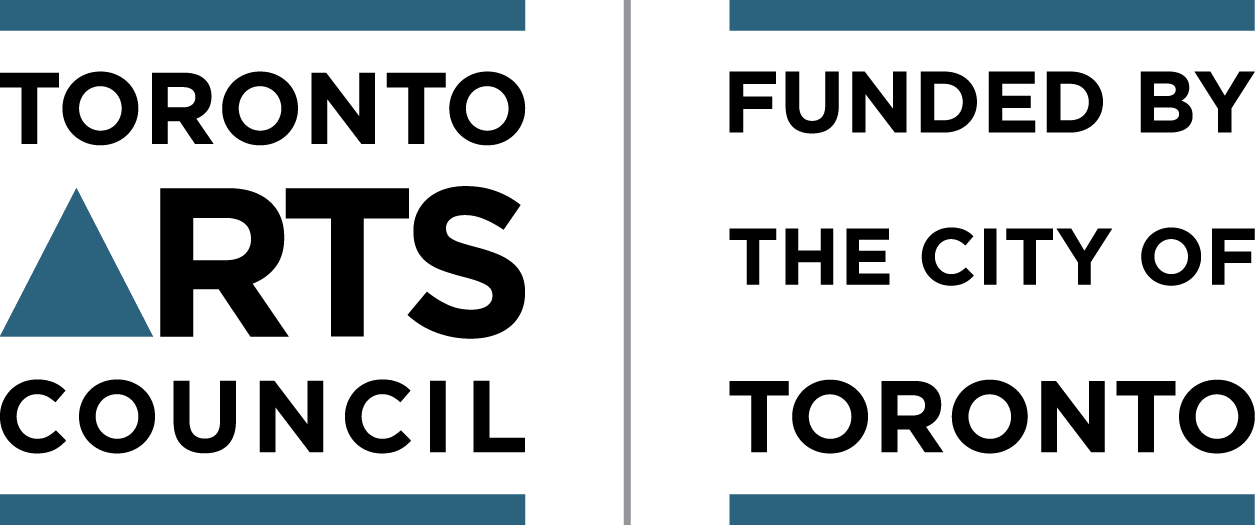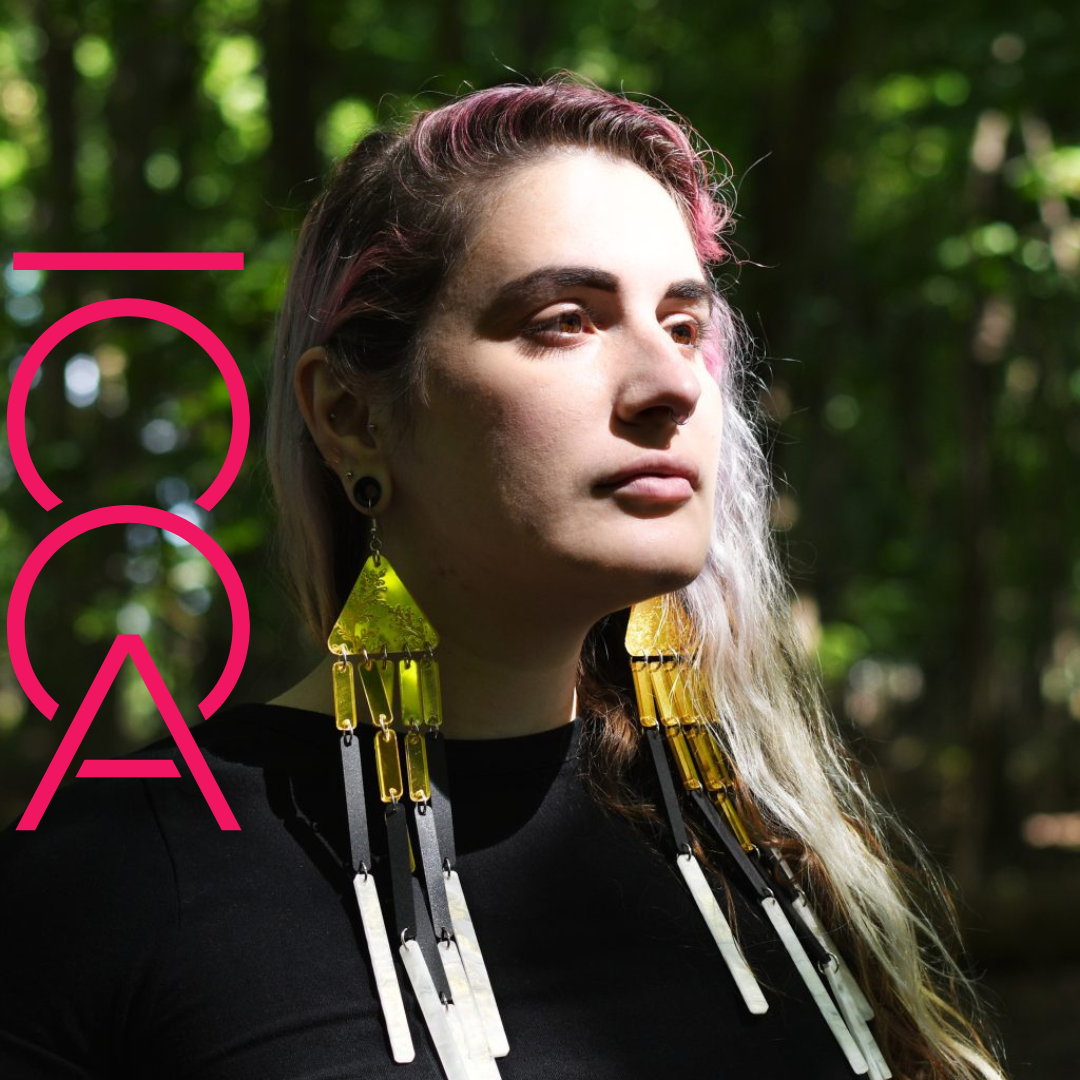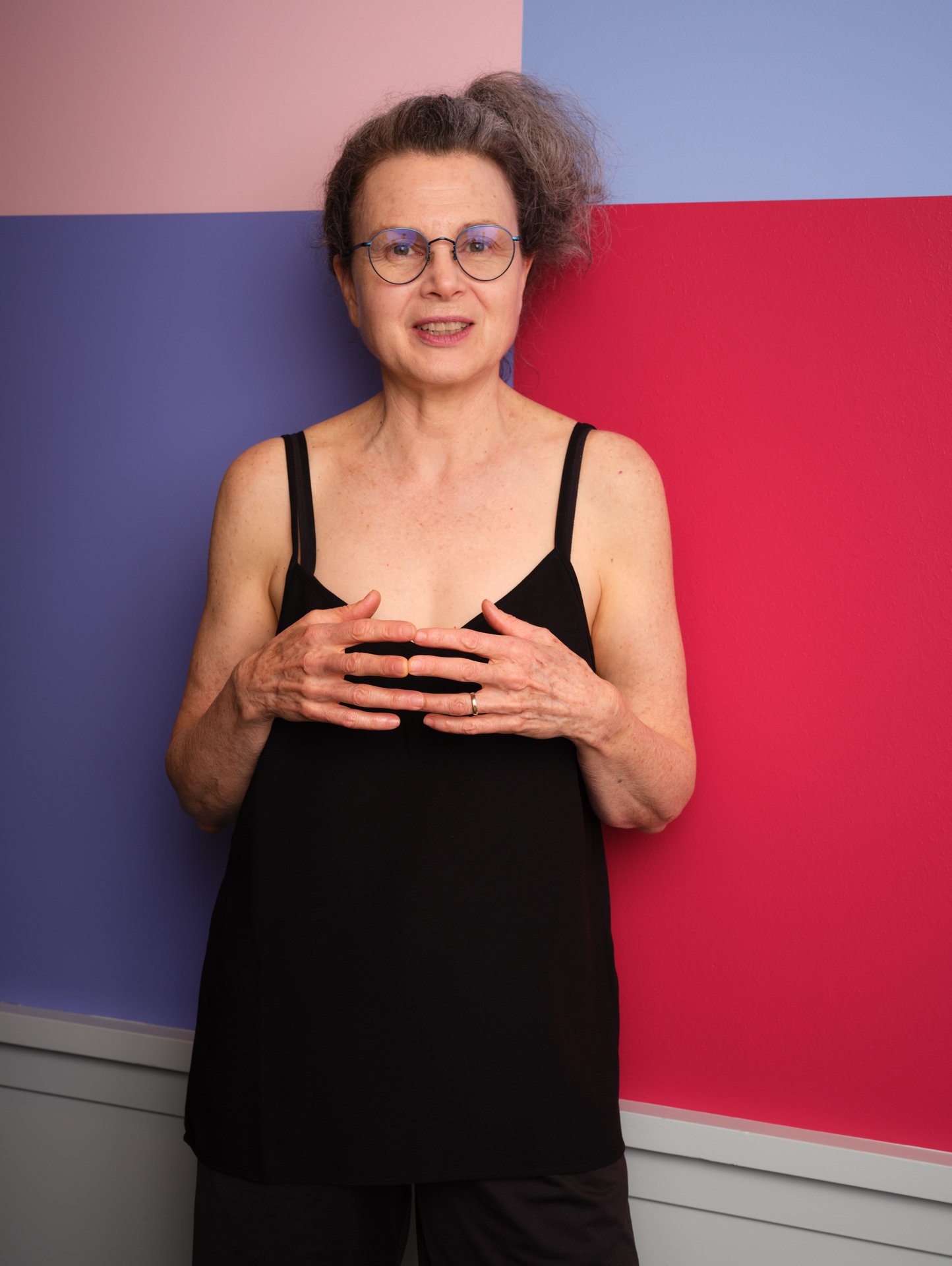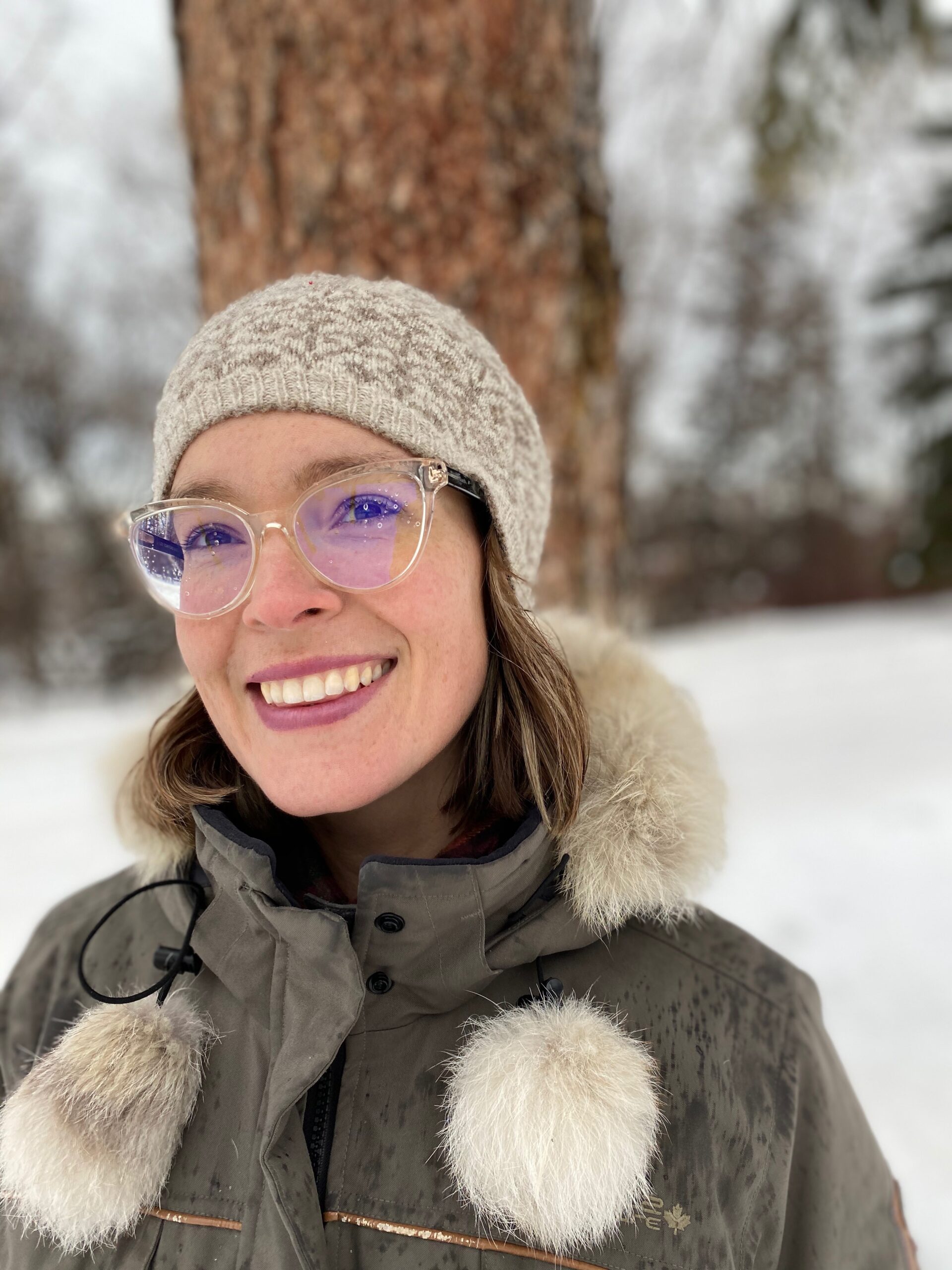À venir dans les histoires Documentaire bispirituel en Saskatchewan de Marjorie Beaucage
Marjorie Beaucage : guerrière arc-en-ciel et art-iviste
Par le Dr Michelle S. A. McGeough
« Parfois, ma caméra se fait témoin, parfois elle se fait miroir . »(1)
Marjorie Beaucage
À l’âge de 40 ans, Marjorie Beaucage a ressenti le besoin de se nourrir sur le plan spirituel. Elle s’est donc enfuie de chez elle pour aller fréquenter une école de cinéma (2). Au cours de ses trente-cinq années passées à réaliser des films, le travail de Marjorie se distingue surtout par son amour profond pour les gens. Ses films démontent les clichés; parfois, ils se veulent expérimentaux et ludiques et, d’autres fois, ils traitent de sujets compliqués comme le deuil, le système judiciaire, la justice environnementale, le VIH et le sida.
Si Beaucage évite d’employer le terme « carrière », elle compte néanmoins plus de 33 films à son actif. « Ce n’est pas vraiment une carrière pour moi, je ne la considère même pas comme ça; c’est juste ma façon de contribuer à faire entendre la voix des gens . »(3) Pour elle, la réalisation cinématographique représente une corde de plus à son arc, et elle parle de ses films comme des projets de collaboration. Il importe, selon Beaucage, d’établir des liens et d’entretenir les relations nécessaires pour faire advenir des changements et de la justice sociale pour les peuples autochtones.
La défense des droits se trouve au cœur de tous les aspects de la vie de Beaucage. Chaque projet qu’elle entreprend repose sur un principe directeur : comment contribue-t-il à répondre aux besoins des personnes autochtones? Son engagement va au-delà de la réalisation de films; elle raconte notamment que, dans les premiers temps du cinéma autochtone, « nous n’avions aucun contrôle sur la distribution, la production, ou même notre voix et notre façon de nous représenter ».(4)
Au début des années 1990, elle devient coordinatrice de l’Aboriginal Film & Video Art Alliance (AFFVA) au Banff Centre for the Arts. Sous sa direction, l’AFFVA élabore un langage médiatique autochtone en plus de plaider pour une gestion autochtone des programmes et des ressources au sein des institutions culturelles canadiennes. Pendant son mandat, l’AFFVA forge des alliances et des partenariats avec le Banff Center, le Conseil des arts du Canada et V-tape. Les débuts sont ardus, raconte Beaucage, compte tenu du racisme généralisé à l’époque. Elle décrit sa fonction comme celle d’une ambassadrice culturelle entre la communauté cinématographique autochtone et les institutions : « j’ouvrais des portes ou je les défonçais, au besoin ».(5) Cette détermination se reflète dans les actions de plaidoyer de l’AFFVA pour assurer le contrôle autochtone des histoires racontées à leur sujet. En 1992, Beaucage organise le premier festival de films autochtones à Toronto, Reel Aboriginal, le précurseur de l’actuel ImagineNATIVE Film and Media Arts Festival, acclamé à l’échelle internationale.
Malgré son engagement dans de nombreux projets, Beaucage réussit le tour de force de réaliser des films. Peu de cinéastes évoquent avec fierté l’une de leurs premières créations, mais ce n’est pas le cas de Beaucage qui se remémore avec beaucoup d’enthousiasme son film Ntapueu… i am telling the truth (1997). Le film décrit les conséquences environnementales de la mine de nickel de Voisey Bay sur le peuple innu du Labrador. Leur connaissance intime des territoires se reflète à l’écran. La narration se fait en langue innue tandis que les sous-titres en anglais expliquent au public les changements survenus dans la communauté depuis l’introduction du christianisme et l’empiètement du Sud. Le film se révèle visionnaire, à la fois par son usage de la langue innue et par son témoignage des liens qui unissent les gens à leur territoire ancestral. Ces liens se déploient grâce au récit de leurs traditions orales et aux images qui témoignent de leur vie quotidienne.
Beaucage raconte avoir d’abord décliné l’offre de réaliser le film : « Ce n’était pas mon histoire à raconter. » Elle a alors proposé : « Je vais vous donner les outils et je vais vous aider. »(6) Pendant un an, elle a travaillé aux côtés des Innus pour leur apprendre le métier de cinéaste. Cette approche d’autonomisation, par le partage des moyens pour raconter leur histoire, s’avère une caractéristique déterminante de la démarche de réalisation de Beaucage.
La mise en commun des outils de création pour permettre aux gens de raconter leur histoire a aussi inspiré la collaboration autour du projet cinématographique Proz Anthology (2000). Issu du programme Take Part in Art de Regina, le film a amené Beaucage à collaborer avec d’anciennes travailleuses du sexe. Elle décrit la trilogie de vidéos réalisées comme « une dramatisation, un poème visuel et un autoportrait ». (7) Deux des vignettes, Prairie Passions et Self-Portrait, dénoncent l’hypocrisie des gens qui jugent les travailleuses du sexe en raison de leur métier. Prairie Passions donne l’heure juste et réfute les stéréotypes véhiculés par les médias sur les travailleuses du sexe. On y découvre des femmes éduquées dont le parcours ne se limite pas à des circonstances tragiques. Ces femmes savourent leur sororité, un lien forgé par l’appartenance à une communauté qui respecte leur choix. Self-Portrait propose un regard cru sur l’univers d’Evening Star, une travailleuse du sexe. La caméra portable fait défiler des images de son appartement; sa table de maquillage, les œuvres d’art qu’elle a peintes et l’autel sur son téléviseur. Des effets spéciaux et l’autodérision d’Evening Star viennent atténuer sa vulnérabilité, car derrière son sourire et ses timides mouvements de tête se profile un rejet de la victimisation. Elle pose la question suivante : qu’est-ce qui la différencie d’une femme qui ne revoit jamais un homme après un rendez-vous d’un soir? La dernière vignette de la série, Death’s Alley, présente un poème visuel d’une tristesse saisissante. La création parlée contextualise les images à l’écran, la réalité de la vie dans la rue; bon nombre n’y survivent pas. Voilà un sombre rappel d’une réalité qui ne figure pas dans les deux autres films.
Si les films documentaires demeurent sa spécialité, ses films plus expérimentaux se révèlent à la fois délicieusement ludiques et émouvants. I’ll do Anything for you dear, un film réalisé par Beaucage au cours de ses études, explore la relation mère-fille. Le film en noir et blanc s’ouvre sur des séquences en apparence banales d’activités quotidiennes et d’interactions entre une jeune fille et sa mère. Le film retrace ensuite le voyage d’une amie chez elle pour rendre visite aux Aînées et aux matriarches de sa famille. Sans entendre les conversations, l’on reconnaît les scènes familières autour d’une table de cuisine, des moments qui donnent lieu à des rires et des échanges enjoués. Le film se termine par des séquences où la mère de Beaucage lui rend visite à Toronto pour assister à la première de son film Bingo. La cinéaste braque la caméra sur sa relation avec sa mère pour évoquer les vulnérabilités et les complexités de cette relation entre femmes. Le charme et la richesse de ce film résident dans la bande sonore doublée. En visionnant le film, l’on entend une voix d’enfant chanter les paroles de « I will do anything for you » et de « Skinny Marinky Dinky Dink », des chansons populaires auprès des enfants. Beaucage rappelle l’amour inconditionnel et la spontanéité de l’enfance. Ces déclarations d’amour chantées par un enfant, conjuguées aux images de mères et de filles, soulignent l’importance de ce lien. L’on se rappelle aussitôt notre lien avec notre propre mère, avec toutes ses joies et ses difficultés.
Beaucage aborde volontiers des sujets difficiles, même lorsque ceux-ci relèvent de sa propre expérience. Son film Good Grief brosse un portrait intime de sa famille confrontée à la perte soudaine de son jeune frère. Tourné un an après son décès, le film relate le processus de deuil des membres de la famille. La caméra de Beaucage saisit le paradoxe du deuil : alors que l’on pleure la perte d’un être cher avec d’autres, notre façon d’accepter la mort demeure une expérience singulière.
Ces dix dernières années, Beaucage mène des projets axés sur la communauté bispirituelle et Indigiqueer. Elle décrit son objectif comme visant à soutenir les jeunes personnes bispirituelles et Indigiqueer à accéder à leur héritage culturel et à conscientiser les gens aux conséquences de l’homophobie sur la vie de ces jeunes . (8) Le film Coming In Stories, Taking Our Place, Two Spirit In Saskatchewan fait découvrir les enseignements cris d’Alex Wilson sur le genre. Les enseignements du trickster Wesakaychak, selon Wilson, incarnent une vérité fondamentale : « chaque créature vivante et tout ce qui agit dans et sur le monde revêtent une signification spirituelle ». (9) Cependant, en raison de l’homophobie persistante, de nombreuses jeunes personnes bispirituelles et Indigiqueer subissent le rejet de leur famille et, par conséquent, se retrouvent dans des situations d’itinérance, de consommation abusive, de violence et de victimisation. Les témoignages de jeunes personnes bispirituelles présentés dans le film font état des conséquences bien réelles de l’homophobie. Celles-ci sont souvent citées pour expliquer le taux élevé de suicide de cette population .(10) Le film de Beaucage rappelle les enseignements cris sur l’amour et le respect de tous les êtres.
Ces enseignements d’amour et de respect définissent les trente-cinq années de réalisation de Beaucage. Sa compassion et sa vision mettent en lumière des histoires qui autrement nous auraient échappé. Là où d’autres jugeraient sa démarche risquée, elle estime que son métier de cinéaste doit s’exercer ainsi. « Lorsqu’on partage des histoires avec d’autres, on tisse un lien. C’est un lien d’humain à humain, parce qu’on a tous·tes des histoires . » (11)
1 Entretien avec Beaucage, le 27 juin 2022.
2 Entretien avec Beaucage, le 27 juin 2022.
3 Entretien avec Beaucage, le 27 juin 2022.
4 Entretien avec Beaucage, le 27 juin 2022.
5 Entretien avec Beaucage, le 27 juin 2022.
6 Entretien avec Beaucage, le 27 juin 2022.
7 Beaucage, Marjorie. Proz Anthology.https://vimeo.com/marjoriebeaucage Consulté le 8 septembre 2022
8 Entretien avec Beaucage, le 27 juin 2022.
9 Alex Wilson, “N’tacimowin inna nah’; Our Coming In Stories”, Canadian Women Studies (2008), 26 (3-4), p. 194.
10 L’une des difficultés de la collecte des données tient au fait que les enquêtes sur les suicides ne recensent pas l’identité de genre des personnes décédées. Malgré le manque de recherche sur les taux de suicide ou le risque de suicide chez les jeunes personnes bispirituelles au Canada, une récente étude aux États-Unis, le Trevor Project, s’est déroulée en 2020. Selon les conclusions, les jeunes LGBTQ+ autochtones sont 2,5 fois plus susceptibles de faire une tentative de suicide que leurs homologues allochtones. Les jeunes autochtones qui subissent de la victimisation sont trois fois plus susceptibles de faire une tentative de suicide. Ce risque diminue de 60 % pour les jeunes LGBTQ+ autochtones qui bénéficient du soutien de leur famille et d’un environnement pédagogique accueillant.
11 Entretien avec Beaucage, le 27 juin 2022.
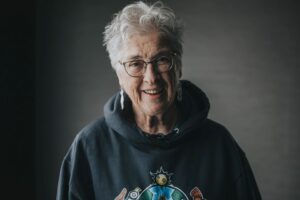
Marjorie Beaucage is a Two-Spirit Métis Auntie, filmmaker, art-ivist, and educator, a land protector and a water protector. Born in Vassar, Manitoba, to a large Métis family, Marjorie’s life’s work has been about creating social change, working to give people the tools for creating possibilities and right relations. Whether in the classroom, community, campsite or the arts, Marjorie’s goal has been to pass on the stories, knowledge, and skills that will make a difference for the future. For Marjorie, the story is medicine.
As a Two-Spirit Métis Elder, Marjorie takes on the tough topics that need to be discussed. Her work is focused on giving voice to and creating safe cultural spaces for, traditionally silenced or excluded groups. Marjorie is known on the local, regional, and national levels as an Elder who speaks truth to power, and who holds space for difference. She has been a Grandmother for Walking With Our Sisters; the Elder for OUT Saskatoon and the youth-led Chokecherry Studios. She has also been called on for national research initiatives that focus on Indigenous women living with HIV, Indigenous Harm Reduction, Indigenous youth who experience sexual and gender-based violence, and post-traumatic stress.
She has created over 35 community-based videos, including her recent harm reduction video portraits on reducing the harms of colonialism. In all of these, Marjorie returns to story as medicine, to art as medicine. Marjorie says of her work, “Creation is a powerful thing; whether you’re making a baby or a loaf of bread or a movie, it comes from the same place. To get people to tap into that energy, that creates possibilities, so they don’t get stuck in this craziness that we’re in is transformative.” Her recent book, Leave Some For The Birds – movements for justice is also part of her legacy for the future.
 Dr. Michelle S. A. McGeough (Cree Métis/Settler) completed her PhD in Indigenous art history at the University of New Mexico. Prior to returning to school for her advanced degree, she taught Museum Studies at the Institute of American Indian Art and was the Assistant curator at the Wheelwright Museum of the Native American Indian in Santa Fe, New Mexico. Dr. McGeough has a Master’s degree from Carleton University as well as a BFA from Emily Carr and an undergraduate degree from the Institute of American Indian Art. She also has a B.Ed. degree from the University of Alberta. Dr. McGeough currently teaches at Concordia University in the Art History department.
Dr. Michelle S. A. McGeough (Cree Métis/Settler) completed her PhD in Indigenous art history at the University of New Mexico. Prior to returning to school for her advanced degree, she taught Museum Studies at the Institute of American Indian Art and was the Assistant curator at the Wheelwright Museum of the Native American Indian in Santa Fe, New Mexico. Dr. McGeough has a Master’s degree from Carleton University as well as a BFA from Emily Carr and an undergraduate degree from the Institute of American Indian Art. She also has a B.Ed. degree from the University of Alberta. Dr. McGeough currently teaches at Concordia University in the Art History department.
Dr. McGeough’s research interests have focused on the indigenous two-spirit identity. She is a board member of Daphne, the first Indigenous artist-run centre in Tiohtià:ke. She is a co-applicant in the SSCHR Thinking Through the Museum Partnership grant, Queer Operatives, and The Morrisseau Project. Her essays have appeared in C-space, Union Docs, and an upcoming volume entitled Two-Spirit, Indigiqueer, and LGBTTQ* Interventions into Museums, Archives, and Curation. Other areas of her research include the application of Indigenous research methodologies and the incorporation of these ways of knowing into the development of curriculum and the curation of contemporary and historic Indigenous art. Currently, Dr. McGeough teaches Indigenous art histories in Concordia University’s Art History department. She is also an independent curator and has curated exhibitions for Daphne, the I.D.E.A. at Colorado College, the Indigenous Art Center in Ottawa, and the Museum of Contemporary Native American Art in Santa Fe New, Mexico.

